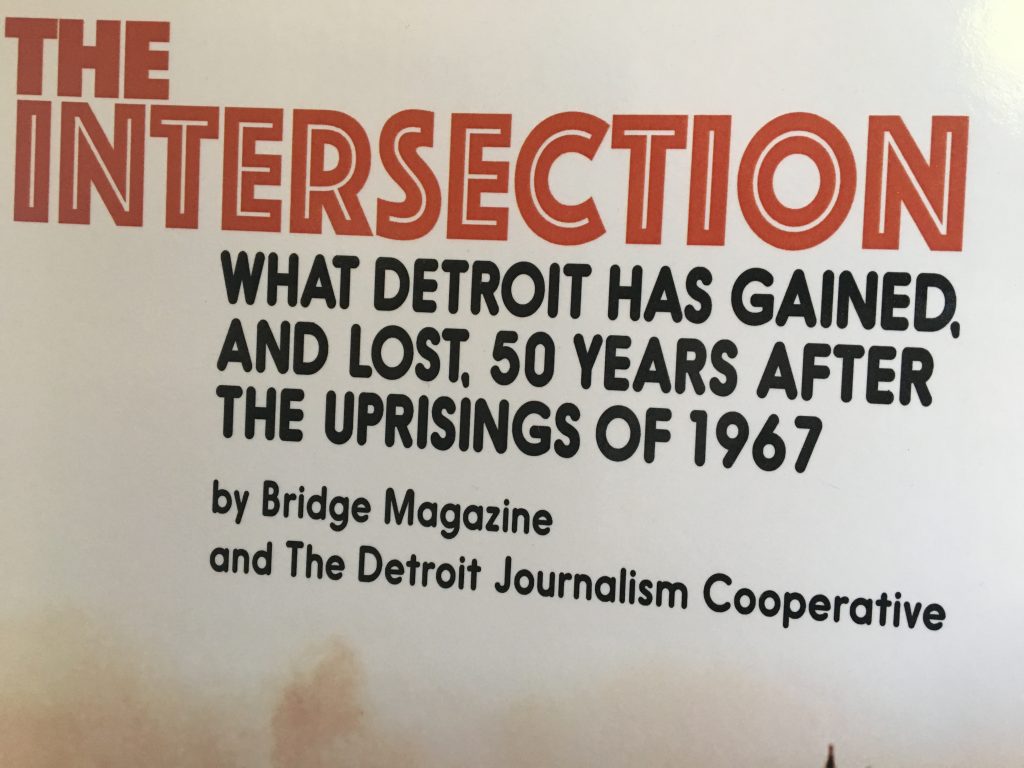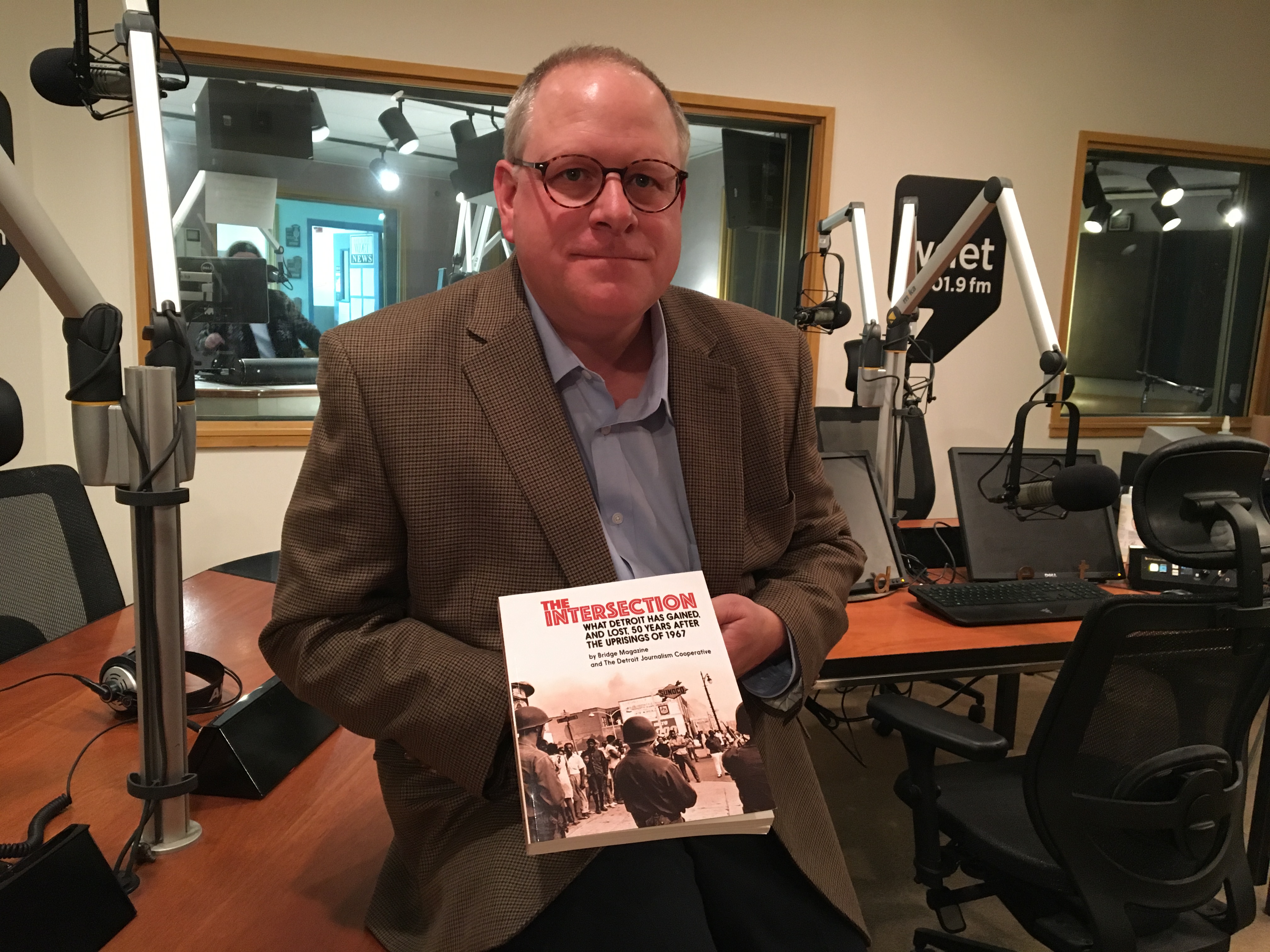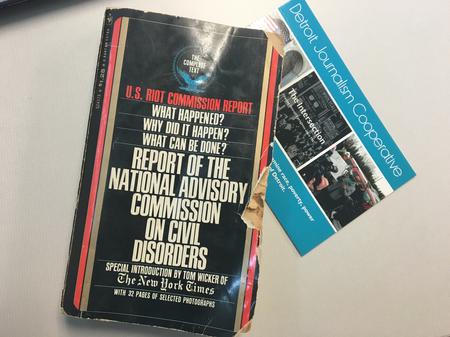“The Intersection”: Book Provides Perspective on 1967
WDET work is part of a new book looking at what’s changed — and what has not — since 1967 in Detroit.


WDET reporters and producers have some of their work included in a new book — a published version of “The Intersection” project.
The initiative last year looked at recommendations made by the Kerner Commission, the presidentially appointed effort to examine causes of urban unrest in several U.S. cities including Detroit in the late 1960s. “The Intersection” project also reported about conditions then and now in metro Detroit related to racial equity and attitudes around several policy areas. It was part of WDET’s work with the Detroit Journalism Cooperative, an effort that began in 2014 to chronicle the city’s bankruptcy case and continues as partnerships in reporting on the city and its metro area.
John Bebow, president and CEO of the Center for Michigan and Bridge Magazine, which edited the book, spoke with WDET’s Sandra Svoboda about the book. Click on the audio link above to hear the conversation or read the transcript below.
Stephen Henderson, host of WDET’s “Detroit Today” program, authored the foreward to the book, writing:
“There are so many ways that the factors that led to the uprising are still with us. There are so many reminders, both physical and metaphorical. If there is good news, 50 years after the 1967 uprising, it is probably that we are all much more honest about the ways in which the problems of then still haunt us now.”
Order the book here.
Here are is some other media coverage about the project from WDET’s DJC partners:
From Bridge: “The Intersection” book explores race, rebellion and the damage done in 1967 Detroit
From DPTV: American Black Journal’s conversation with book contributors
From Michigan Radio: Stateside program about the book
Full Interview:
Sandra Svoboda: Why should people buy this book?
John Bebow: If you care about Detroit history, if you care about the many commemorative events that are taking place this summer, I think the book provides some good perspective. We call it “The Intersection” because the story goes out from that corner – 12th and Clairmount – where the disturbance started all those years ago. We trace crime. We trace quality of life. We trace the health and education of the populace, and real estate and diversity and segregation questions, all the way out from that time because readers don’t have clip files as we say in the newsroom. And also , if you go back in time and look at the history of that time, if you look at the official Lyndon Johnson government report that came out of it, the Kerner Commission Report, it made some startling conclusions.

It basically said we’re moving toward two societies: one white, one black, separate but unequal. They said moving toward. So what we sought to do in the year we spent on this book was to measure, well are we moving toward that still? And I think what readers will see in the books, in some ways, we’ve arrived. We’re no longer moving toward separate and unequal, but in some ways we’ve arrived and in other ways we’ve made great progress. That’s what I hope readers get out of the books is some perspective beyond all the imagery that is so familiar.
Sandra Svoboda: The book took the work of several reporters and producers at a lot of different media outlets within the Detroit Journalism Cooperative. We have TV, public radio including WDET, and Bridge, the online magazine, as well as five ethnic newspapers. What was it like putting the work from those outlets together in a book?
JB: For the reader I think it’s a real collaboration of diverse perspectives. You have African American and white reporters. You have Arab-American reporters, Jewish reporters. The truth is the events of 1967 impacted all cultures in this region in some capacity and we thought it was really important to provide that kind of diverse perspective on how it has affected all those communities. That isn’t often done intentionally in media in metro Detroit, and I think it’s one of the things that makes the book special.
SS: There are a lot of events and works that will be held this summer in conjunction with the 50th anniversary of those events. Where does “The Intersection” book fit in with those?
JB: Well, it’s not ruin porn. You’re not going to see 200 pages of pure destruction. You can go on YouTube tonight and see the news coverage from 1967. It’s perspective. It’s meant to be thoughtful and to get people thinking about where we’ve come and how far we have yet to go. So “The Intersection” is a guide to help people navigate their own thoughts about all of this.
SS: Where can readers get a copy of it?
JB: Readers can get a copy online through Amazon. They can also buy on the Bridge magazine website. We are also working to get the book in museums and bookstores throughout the region. We hope to have it available at a wide range of commemorative events throughout the summer.
